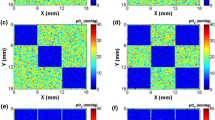Abstract
The purpose of this study was to investigate the oxygen enhancement ratio (OER) effects on treatment planning for a hypoxic prostate tumor with proton scanning beams. Two different OER-based dose calculation models (the average model and the voxel model) were investigated by using hypoxic tumor models in this simulation study. For the hypoxic tumor model, an oxygen distribution with a range of 2.4–9.4 mmHg was used according to the clinical data. The results given by the average model and the voxel model were compared for 50% and 90% tumor control probabilities with variations in the hypoxic tumor volume and fractionation. Comparison between the treatment plans with OER-based higher predicted dose and with the conventional prescription dose was conducted to investigate the organ-at-risk (OAR) doses for the prostate case. The average model showed a higher calculated dose than the voxel model. The voxel model with a 50% control probability showed good agreement with the current prescription dose. The OER values of the average model ranged from 1.05 to 1.25, which were applied to the whole tumor volume in treatment planning. The voxel-model-based OERs were higher (1.50–1.75) than those of average model, and these OERs should be applied only for the hypoxic boost region. Regarding treatment plans, the doses of the rectum and the bladder were reduced to the tolerable range V80Gy (volume receiving equal to or greater than 80Gy) < 15% and V75Gy (volume receiving equal to or greater than 75Gy) < 15% respectively after an optimization, but the maximum dose to femoral heads was higher than 50 Gy. In conclusion, we investigated the possible ranges of the OER (1.3–1.8) for proton-beam treatment of prostate cases. A dose escalation of up to about 1.8 times can be applied for the small hypoxic region. This result, which was obtained using a model study, should be verified through clinical experiment.
Similar content being viewed by others
References
A. J. Lomax et al., Med. Phys. 31, 3150 (2004).
I. Yeo et al., Radiat. Oncol. 10, 213 (2015).
W. Cao et al., Cancers 7, 574 (2015).
N. J. Sanfilippo and B. T. Cooper, Am. J. Clin. Exp. Urol. 2, 286 (2014).
B. S. Hoppe, C. Bryant and H. M. Sandler, J. Urol. 193, 1089 (2015).
H. Chung et al., J. Appl. Clin. Med. Phys. 18, 32 (2017).
D. J. McKenna, R. Errington and K. Pors, J. Cancer Metastasis Treat. 4, 1 (2018).
A. Turaka et al., Int J. Radiat. Oncol. Biol. Phys. 82, e433 (2012).
M. Milosevic et al., Clin. Cancer Res. 18, 2108 (2012).
E. Lalonde et al., Lancet Oncol. 15, 1521 (2014).
H. B. Ragnum et al., Br. J. Cancer 112, 382 (2015).
C-T. Lee, M-K. Boss and M. W. Dewhirst, Antioxid. Redox Signal. 21, 313 (2014).
J. G. Rajendran et al., Eur. J. Nucl. Med. Mol. Imaging 30, 695 (2003).
F. Dehdashti et al., Eur. J. Nucl. Med. Mol. Imaging 30, 844 (2003).
M. Zimny et al., Eur. J. Nucl. Med. Mol. Imaging 33, 1426 (2006).
K. Hirata et al., Eur. J. Nucl. Med. Mol. Imaging 39, 760 (2012).
Y. Wang et al., PLoS ONE 12, 0173016 (2017).
M. W. Dewhirst and S. R. Birer, Cancer Res. 76, 769 (2016).
T. Hompland et al., Cancer Res. 78, 4774 (2018).
J. P. B. O’Connor, S. P. Robinson and J. C. Waterton, Br. J. Radiol. 92, 20180642 (2019).
S. Dadgar, J. R. Troncoso and N. Rajaram, J. Biomed. Opt. 23, 067001 (2018).
T. Wenzl and J. J. Wilkens, Radiat. Oncol. 6, 171 (2011).
E. Lindblom et al., Radiat. Oncol. 9, 149 (2014).
L. Antonovic et al., J. Radiat. Res. 55, 902 (2014).
L. Antonovic, A. Dasu, Y. Furusawa and I. Tomo-Dasu, J. Radiat. Res. 56, 639 (2015).
E. Scifoni et al., Phys. Med. Biol. 58, 3871 (2013).
W. Tinganelli et al., Sci. Rep. 5, 17016 (2015).
O. Sokol et al., Phys. Med. Biol. 62, 7798 (2017).
I. Tomo-Dasu, A. Dasu and A. Brahme, Acta Oncol. 8, 1181 (2009).
L. Strigari et al., Phys. Med. Biol. 63, 065012 (2018).
V. Anferov and I. J. Das, Int. J. Med. Phys. Clin. Eng. Radiat. Oncol. 4, 149 (2015).
A. Dasu, I. Tomo-Dasu and M. Karlsson, Acta Oncol. 44, 563 (2005).
T. T. Puck and P. I. Marcus, J. Exp. Med. 103, 653 (1956).
M. Guerrero and X. A. Li, Phys. Med. Biol. 49, 4825 (2004).
P. Clint et al., Int. J. Radiat. Oncol. Biol. Phys. 70, 847 (2008).
D. J. Carlson et al., Phys. Med. Biol. 49, 4477 (2004).
T. Girinsky et al., Int. J. Radiat. Oncol. Biol. Phys. 25, 3 (1993).
M. Krmer and M. Scholz, Phys. Med. Biol. 45, 3319 (2000).
A. Dasu and I. Toma-Dasu, Acta Oncol. 51, 963 (2012).
A. Brahme and A. K. Agren, Acta Oncol. 26, 377 (1987).
B. Emami, Rep. Radiother. Oncol. 1, 35 (2013).
Y. L. Kim et al., Prog. Med. Phys. 29, 106 (2018).
Acknowledgments
This research was supported by the National Research Foundation of Korea (NRF) grant funded by the Korea governments Ministry of Science and ICT (MSIT) (No. NRF-2020R1A2C4001910 and NRF-2020M2D9A1094075).
Author information
Authors and Affiliations
Corresponding author
Additional information
Electronic supplementary material
The online version of this article contains a supplementary material, which is available to authorized users.
Rights and permissions
About this article
Cite this article
Yoo, S.H., Geng, H., Lam, W.W. et al. Study on Treatment Planning for the Prostate in Proton Therapy with Oxygen Enhancement Ratio Effect. J. Korean Phys. Soc. 77, 613–623 (2020). https://doi.org/10.3938/jkps.77.613
Received:
Revised:
Accepted:
Published:
Issue Date:
DOI: https://doi.org/10.3938/jkps.77.613




